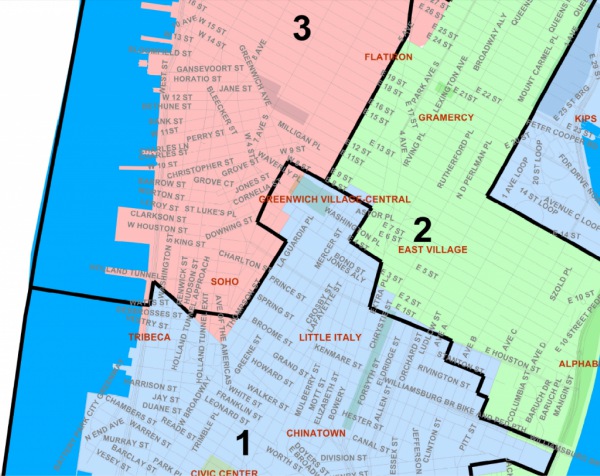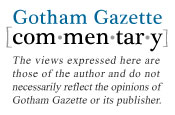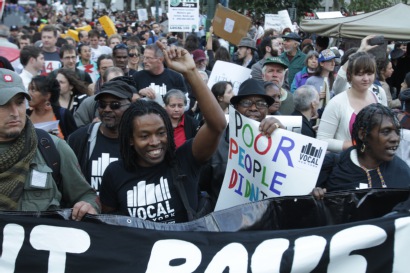Downtown, West Side to Lose Voting Power Under Council Redistricting Plan

After many delays and revisions, the New York City Districting Commission has presented its final proposed new City Council district map to the City Council for approval. Every ten years, the City Council’s lines, like those of every legislative body in the country, must be changed to reflect changes in population as determined by the Census. As the Council has ultimate authority over land use decisions and landmark designations, its decennial redistricting is of course of great interest to us.
One might expect pretty substantial changes in the boundary lines of the 1st, 2nd, and 3rd Council districts. These districts encompass the Village, East Village, and NoHo, among many other downtown and West Side neighborhoods, and each of these districts grew faster than the city as a whole (in fact, the 1st had one of the largest population increases of any district in the city, while the 3rd , consisting of much of the Village, Chelsea, and Hell’s Kitchen, had the largest of all fifty-one districts).
But in spite of these dramatic population changes, the Commission proposes only very slight changes to the boundaries of the 1st, 2nd, and 3rd Council districts, unlike many others in the city. This means that residents of the Village, East Village and the other neighborhoods in these three districts would be among the most underrepresented in the City Council under the proposed new plan. In fact, residents of the 1st and 3rd Council districts, which include most of the Village, would actually be the most underrepresented in the City Council, and have the least voting power, of any residents in the entire city.
___
Andrew Berman is the Executive Director of the Greenwich Village Society for Historic Preservation.
Guest Commentary: Means, Ends and State Constitutional Reform

Politicians weigh means against ends every day. It’s part of the job description. In a masterful film, Steven Speilberg showed us how Lincoln balanced means and ends as he sought the abolition of slavery. The message: bend the rules, but don’t break them: trading jobs for votes was O.K. to pass the 13th amendment; buying them for cash, not O.K. It worked. History was made.
We are not hearing too much these days about New York state government being dysfunctional. Fiscal discipline has been established. Gay marriage was passed. A new decentralized regional economic development paradigm was put in place and made to work. After years of wrangling, scandal and stasis, Gov. Andrew Cuomo has shown that New York State government can get things done.
 He saw another opportunity to get things done in the tsunami of public demand for action in response to the tragic massacre of children at Newtown Connecticut. Though gun control was not on his announced agenda for the 2013 legislative session, he promised “the toughest assault weapon ban in the nation.” Cuomo wanted The New York SAFE Act passed fast — both because the iron was hot, and because of the danger that gun control would preempt his pre-laid plans for the session. And he wanted it passed first: before any other governor; before the president. To restore New York’s leadership, he said. To elevate his own political prospects, others opined.
He saw another opportunity to get things done in the tsunami of public demand for action in response to the tragic massacre of children at Newtown Connecticut. Though gun control was not on his announced agenda for the 2013 legislative session, he promised “the toughest assault weapon ban in the nation.” Cuomo wanted The New York SAFE Act passed fast — both because the iron was hot, and because of the danger that gun control would preempt his pre-laid plans for the session. And he wanted it passed first: before any other governor; before the president. To restore New York’s leadership, he said. To elevate his own political prospects, others opined.
The governor lined up the votes, and issued a Message of Necessity. By this means the constitutional three day waiting period in the Legislature for acting on legislation was bypassed. No matter that Cuomo had previously been critical of the use of such messages in the absence of a true emergency, and in fact had refused to issue one while still passing a timely budget last year. The gun control bill passed. The end justified the means.
When things seem to be working, governmental structures and processes are a concern for a few professors, a few lawyers, an occasional elected official and a handful of others organized in so-called “good government’ (goo goo) groups. Legislators and lobbyists don’t usually embrace changes in ways of doing business that that they know intimately, and that have made them winners. Their mantra: “If it ain’t broke, don’t fix it.”
Cuomo came into office when things were widely believed to be broken. His key campaign policy document, The New New York Agenda, embraced a great range of structural reforms in state and local government. Thus far, results have been disappointing. Government reform goals – means – have been traded for fiscal and programmatic goals — ends. The constitutional amendment on legislative redistricting, and now scheduled for a referendum vote in 2014, is a prime example. It does not give us a neutral process. The Legislature remains in control, with the Republicans in the Senate, teetering on the abyss, gaining an insurance policy against Democrats doing unto them in the future what they had always done to Democrats in the past. Hardly reform.
[Editor's Note: Read a letter from Citizens Union and the League of Women Voters on why the constitutional amendment on legislative redistricting was a victory for reform.]
The simple message: making government work is the enemy of reforming government, because it signals — falsely — that institutions and processes need no attention.
Another process change essential for democratizing our politics, campaign finance reform, will again be considered this year. Perhaps with Gov. Cuomo’s leadership, some progress will be made. Yet the agenda is packed, and the opportunities for tradeoffs abound. And even if the influence of big money in our politics can be mitigated through legislation, we still will have what Professor Peter Galie has begun to call our “Potemkin constitution,” full of provisions that have been emptied of meaning through practice or interpretation. We still have a Legislature too diminished in budgetary powers. We still have a judicial system that is in needed of serious structural reform. We still need to give the governor better tools for reorganizing the executive branch.
The “means” of government, how things are structured and should work, is the special province of the state constitution. In the New NY Agenda, Cuomo called for a people’s constitutional convention to address the big “means” questions we face. Cuomo’s success in making our flawed system work does not diminish the urgent need to make that system better. The next time we have a real chance will be in 2017, when the constitution requires that the automatic constitutional convention vote be held.
The opportunity to make the “means” of state government New York’s foremost concern presents Andrew Cuomo with a rare chance for truly transformative leadership: a Lincolnesque moment. Will he seize it?
Why Grassroots Activism Matters to New York City

New York City is simply not working for a large percentage of the population. In Manhattan, the top 20 percent of families earn forty times more than the bottom 20 percent of families. The city’s homeless shelter population continues to grow and includes an unacceptable 20,000 children a night. Poor Black and Latino children are disproportionately likely to attend the most troubled schools with the fewest resources. People on the margins struggle with a fraying social service safety net, and immigrants, homeless people and Black and Latino youth face harsh crackdowns on their basic rights.
The aftermath of Superstorm Sandy brought this reality into stark relief. Firms around Wall Street were up and running in a matter of hours. But just blocks away in Chinatown and the Lower East Side, people had no information or basic essentials for days. And in places like the Rockaways, Coney Island and Midland Beach on Staten Island, residents are still fighting for a return to normalcy. In these and other neighborhoods, local organizations are now coordinating an advocacy campaign to demand proper recovery plans.
 To address inequities like these, North Star Fund is launching a $7 million Activism’s Future campaign. Our goal is to build a robust movement to close the chasm between New York City’s richest and poorest citizens. Through Activism’s Future, we are strategically partnering with grassroots activists in communities most affected by injustice. By growing our commitment to these groups, North Star Fund will strengthen the capacity of activist organizations and coalitions, and will fund victories that greatly improve lives in our city. In the process we will put forth a new model of progressive activism for our nation.
To address inequities like these, North Star Fund is launching a $7 million Activism’s Future campaign. Our goal is to build a robust movement to close the chasm between New York City’s richest and poorest citizens. Through Activism’s Future, we are strategically partnering with grassroots activists in communities most affected by injustice. By growing our commitment to these groups, North Star Fund will strengthen the capacity of activist organizations and coalitions, and will fund victories that greatly improve lives in our city. In the process we will put forth a new model of progressive activism for our nation.
Grassroots activists directly affected by injustice are our best hope for creating real change. They know firsthand which policies aren’t working and which programs must be expanded. And with head, heart and bullhorn, they are taking on City Hall every day. Effective grassroots organizers often wield enormous influence in relation to their size and budget.
To expand grassroots leadership and secure activism’s future, North Star Fund will double its funding to activists so that they can use tools of organizing like public demonstrations, coalition building, and meetings with legislators to stand up for their rights. North Star will also expand the training of local leaders to organize their communities and build alliances to broaden their reach, and increase media coverage of social justice issues.
As a great city, we need to keep issues of equality, economic justice and peace on the front page and in the front of peoples’ minds. Finally, North Star Fund will broaden the community of donors who support activism in order to build a bigger and stronger social justice community.
Activism’s Future we will make New York City a place we can all be proud to call home. And it will safeguard one of our most valuable assets, our community of activists.
___
Hugh Hogan is the executive director of the North Star Fund which, since 1979, has awarded approximately $41 million to over 1,750 community groups — from kitchen table activists fighting for better housing to citywide movements to protect civil rights. Images courtesy of the North Star Fund.




